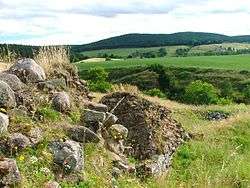Coull Castle
Coull Castle was a 13th-century castle to the south of Coull, Aberdeenshire, Scotland.[1]
| Coull Castle | |
|---|---|
 | |
 Coull Castle | |
| Coordinates | 57.1087°N 2.8063°W |
| Site information | |
| Condition | Ruined |
| Site history | |
| Built | 13th century |
History
The castle occupies an important and commanding position along the northern approach to Aboyne. Built by the Durwards in the 13th century and was the main stronghold of the barony of O’Neill. The last mention of the intact castle was in a charter dated 17th February 1554 from the Queen Regent, Mary I, which grants "the lands of Cowle with their castle and mill, in the sheriffdom of Aberdeen." The castle was ruined by the first half of the 17th Century according to the collections of Sir James Balfour.[2]
The castle ruins were excavated by the landowner Dr Marshall Mackenzie after his purchase of the land in 1912 and the excavations were later continued by W. Douglas Simpson in 1922.[2] The castle consisted of a pentagonal courtyard, with at least three flanking towers. Slight traces of the castle are visible above ground.[1]
References
- Coventry, Martin (2001). The Castles of Scotland. Musselburgh: Goblinshead. p. 175. ISBN 1-899874-26-7
- Simpson, W Douglas (10 December 1923). "The Excavation of Coull Castle, Aberdeenshire" (PDF). The Society of Antiquaries of Scotland. 58: 45–99 – via Archaeology Data Service.
External links